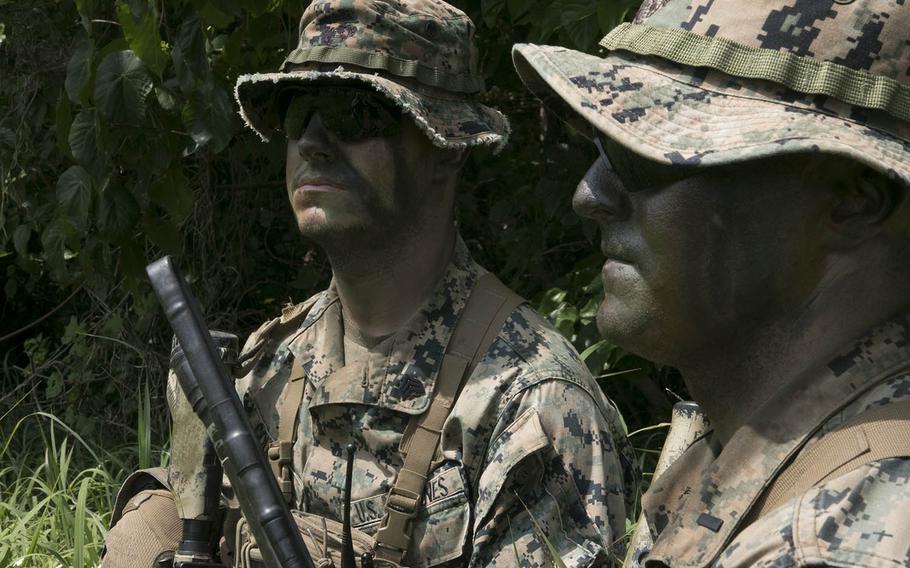
Marines watch over a hidden M142 High Mobility Artillery Rocket System, or HIMARS, during Exercise Castaway on Ie Shima, Okinawa, March 15, 2021. (Matthew M. Burke/Stars and Stripes)
IE SHIMA, Okinawa – U.S. Marines, soldiers and airmen for nearly two weeks polished a new approach to island warfare in the Western Pacific designed to deny surrounding seas to potential adversaries.
They deployed small groups of highly trained troops, fast-moving artillery and stealthy fighter jets to grab territory from which rockets could launch.
Exercise Castaway, which concludes Saturday on this island just off Okinawa’s northwest coast, demonstrates how a relatively small, widely dispersed force could seize and hold useful territory in the early stages of a conflict.
The tactic is called expeditionary advanced base operations. The potential adversary, left unsaid, is widely understood to be China.
Castaway is the second exercise like it since Noble Fury in October, but it’s the most comprehensive expeditionary advanced base exercise, so far, 3rd Marine Division spokesman Maj. Kurt Stahl told Stars and Stripes on Monday.
Noble Fury involved Marines and sailors practicing an island airfield seizure and deploying a Marine M142 High Mobility Artillery Rocket System, or HIMARS. Castaway largely went through the same motions but had the added layers of an actual wartime scenario.
They also demonstrated how to sustain the force for a period afterward. The long-range fire of the HIMARS would deny adversaries easy movement through the surrounding seas.
The exercise started March 8 and involved a force more than 300 strong. Marines from 3rd Reconnaissance Battalion joined by U.S. Army Green Berets of 1st Battalion, 1st Special Forces Group and airmen of the Air Force 320th Special Tactics Squadron led the way. Behind them came the main force from the 3rd Battalion, 8th Marines.
From Marine Corps Air Station Iwakuni came four F-35B Lightning II stealth fighters, capable of short runway take-offs and vertical landings, to provide air cover and seek potential targets.
A week into the scenario, the HIMARS from 3rd Battalion, 12th Marines’ Sierra Battery rolled out the back of a Marine C-130 Hercules airlifter, raised its tubes for a mock fire, then disappeared into the nearby jungle.
“What we’re doing is working on establishing an austere position where we can basically prosecute long-range precision fires, and that allows us to basically deny the sea lane,” said 3rd Battalion, 12th Marines commander Lt. Col. Roe Lemons Jr. after the battery arrived. “For us, it’s like a road intersection, but on the water.”
The expeditionary advanced base concept relies on an “alternative forward force,” that is “difficult to target” and “lethal, yet resilient,” according to a June 2018 handbook prepared by the Marine Corps Warfighting Laboratory at Quantico, Va. These smaller, widely dispersed forces can administer punishing, precision strikes without having to destroy all of an adversary’s forces.
Marines in the field referred consistently to a “peer” adversary. But Castaway was clearly designed to counter an increasingly assertive China, according to Toshiyuki Shikata, a security expert and former lieutenant general for the Japan Ground Self-Defense Force.
“It works as a deterrent to have both a larger diplomatic framework and military exercises,” he told Stars and Stripes by phone Tuesday. Castaway “shows the U.S. military’s capability to deploy reliable weapons in a timely and appropriate manner. It is important to show rather than just talking about it.”
The exercise took place as U.S. attention becomes more focused on the Indo-Pacific region. The U.S. secretaries of defense and state met with their counterparts in Seoul and Tokyo this week, a show of solidarity for rivals China and North Korea.
On March 9, the head of Indo-Pacific Command, Adm. Philip Davidson, told the Senate Armed Services Committee that China could launch an attack on Taiwan in the next six years.
The U.S. helps deter China from using force to assert control over Taiwan by selling it arms and by routinely sending Navy warships through the 110-mile-wide Taiwan Strait.
And the U.S. is also committed to helping Japan defend the Senkaku Islands, a handful of barren, rocky islets whose possession is contested by China and Taiwan.
Stars and Stripes reporter Hana Kusumoto contributed to this report.
burke.matt@stripes.com Twitter: @MatthewMBurke1